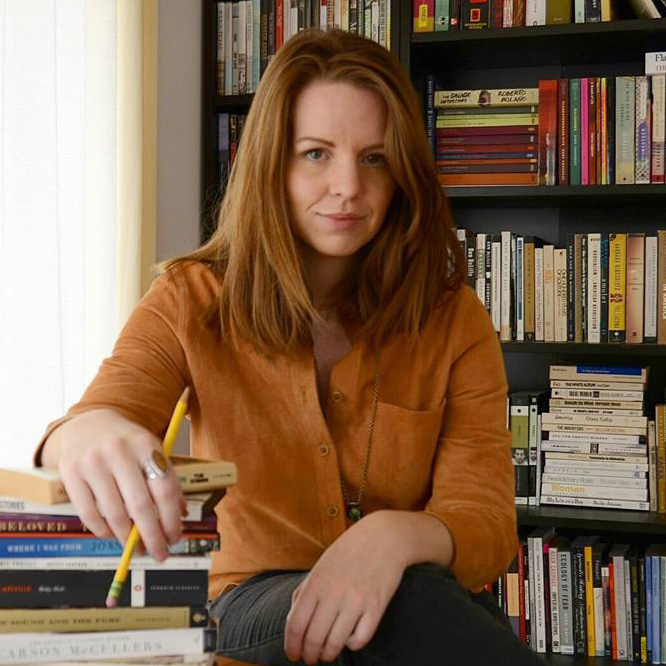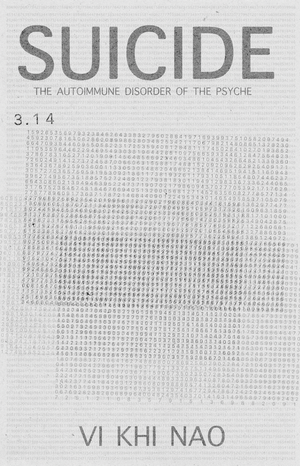Vi Khi Nao
Suicide: The Autoimmune Disorder of the Psyche
11:11 Press, 2023
Paperback, 158 pages
“Girls these days, when they weren’t hugging boys unromantically, were busy being generally aggressive. Whereas girls in my youth felt angry but directed it inward and cut themselves and became depressed, girls nowadays just went arrrrgh and pushed someone into a wall. Who could say which way was better? In the past the girl herself got hurt; now another unsuspecting, innocent person was hurt and the girl herself seemed to feel just fine.”
–The First Bad Man by Miranda July
“I live in the virtue of that life and power that takes away the occasion of all wars.”
-Quaker Testimony of Peace, first declared by George Fox in 1660
*
In January 2011, I lost a friend, who I loved dearly, to suicide. In January 2020, another friend–one who I had traveled and celebrated Christmas with–ended her own life. As someone who now intimately mourns at least two people who died by suicide and has experienced suicidal ideation as well, I can’t help but see the act as prevalent and common. While I may have been the target audience for Vi Khi Nao’s Suicide: The Autoimmune Disorder of the Psyche because of my particular experiential background, the book takes compelling turns into topics of pain and punishment in ways that open up the human condition far beyond the desire for death.
This isn’t just a fringe theme that is a part of Nao’s life, or mine, though. The Centers for Disease Control and Prevention classifies suicide as both a leading cause of death and a serious public health problem in the U.S. From their website:
Suicide rates increased approximately 36% between 2000–2021. Suicide was responsible for 48,183 deaths in 2021, which is about one death every 11 minutes. The number of people who think about or attempt suicide is even higher. In 2021, an estimated 12.3 million American adults seriously thought about suicide, 3.5 million planned a suicide attempt, and 1.7 million attempted suicide.
Because of the unfortunate way suicide connects us all, we absolutely should be talking—and writing—about this much more, not less.
Despite suicide being a repeating motif throughout human history, Nao’s account is a deeply personal and nuanced one. Nao, who could be shallowly labeled as many things, a Vietnamese refugee, lesbian, writer, establishes early on in the book painful circumstances that make daily life difficult for her—chronic health issues that require open-heart surgery to live, among other agonies. This specific flip from actively killing oneself to neglecting life-saving procedures raises interesting philosophical questions. Is choosing not to sustain your own life without the help of others considered harm attempts? If so, then these types of destructive choices are much more widespread than we’d like to admit.
Throughout the book, Nao mentions acts of self-harm that, on the surface, might not appear as punishing as they reveal themselves to be. The book includes scenes of masochistic exercise, refusal of medical procedures, and punishing attempts at cleaning up after oneself in the midst of losing blood. Nao’s skill is to display these vignettes all while leaving space for the reader to make their own connections and discriminations of where the harm comes from, how harm occurs, and at whose hands.
“How do we dictate the violence of our depression? Is it born out of isolation?” she asks. Is connection to others and how we all similarly suffer the antidote? Are we wildly out of practice in opening up to each other’s agonies and supporting open expressions of suffering? Through these questions, I felt detective-like in my examination of the shame-driven acts we use to disguise our torments. Nao includes a passage in which her mother’s cosmetic procedures disfigure her and make her ill. “She had botoxed her two hands to erase her history with pain, hardship, and depression.” Could plastic surgery be considered self-hate and self-flagellation? In this light, it’s hard to argue it as an attempt at beauty.
The autoimmune framework that Nao employs allows us to view the violence that she and her family have endured as ongoing despite it not all originating from within the confines of their biological unit. The rationalist language we’re steeped in woefully underserves the ability to describe how bodies retain and absorb that which occurs to their land(s). However, Nao doesn’t neatly reduce the United States’ geopolitical warmongering in terms of winners and losers, good and bad. One of the most moving passages comes towards the end of the book when she recalls a real-life incident in 2014 when four teenage boys broke into a poultry facility in rural California and killed almost 1000 chickens by beating them with golf clubs.
A simple person might have told the story like this: chicken killers = bad. Instead, Nao asks:
“Why did the boys send themselves to their self-imposed American version of the gulag?”
There is a certain amount of grace extended in taking criminality and retribution out of her consideration of the chicken brutalizing event. By releasing the cyclical thirst for punishment, her approach frees us into an open atlas of human pain where there is little distinction between sufferer and harmer. Nao’s book helps to pull apart the transformation that turns a person who experiences troubles, into a person who is troubled, into a person who is trouble. Much of this has to do with social construct, with reinforcement. It’s not that abusive people are those who have suffered the most, but rather, they haven’t been forced to discover that less-cruel ways of living are possible.
Should the government issue us all punching bags to wallop our anger out on instead of ourselves and others? What would true programs of harm reduction look like not only interpersonally, but structurally? When the United States has been directly responsible for a disproportionate amount of violence around the globe what happens when war becomes internalized? Do we, like Miranda July’s protagonist observed in the quote above, hurt others and actually feel better? Is hurting ourselves any different? Or, how might we, as the radical Quaker mystic and dissenter George Fox said, live in virtue of that life and power that takes away the occasion for wars, even though we’ve been mistreated? Why would I treat myself in ways that I wouldn’t treat the author of this book, the reader of this review? Why would you treat yourself in ways you wouldn’t treat me?
For Nao, the answer lies in other people. She doesn’t leave us with random cruelty and pain but shows repeatedly throughout the book how unexpected kindness appears as a dependable force. Despite the ways the author depicts herself overcome by agony, Suicide: The Autoimmune Disorder of the Psyche, includes a delightful, and surprising amount of humor. Nao’s spirit of generosity is so frequently granted to others, even when she can’t grant it to herself. I was left transformed, and for the better, by the end.
May we all continue to unburden one another. May Nao’s Suicide: The Autoimmune Disorder of the Psyche, and this review, be a balm to all who suffer.

About the Author
Laura Paul has been published by The Brooklyn Rail, LA Review of Books, Entropy Magazine, Pangyrus, Dream Pop Journal, Heavy Feather Review, Hush Lit, and other outlets. She lives in Seattle, where she works at Open Books poetry bookstore. Connect with her on her website laurapaulwriter.com or on Instagram and Twitter @laura_n_paul.
